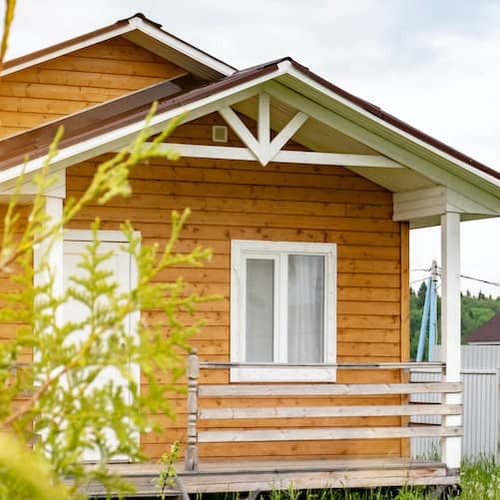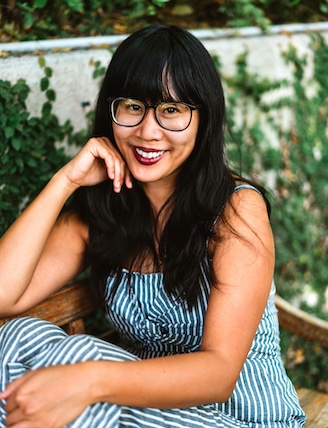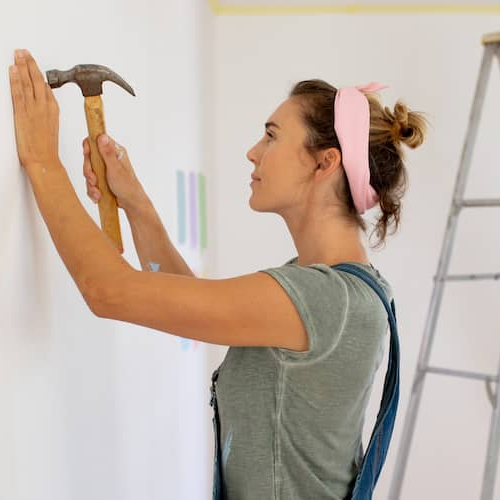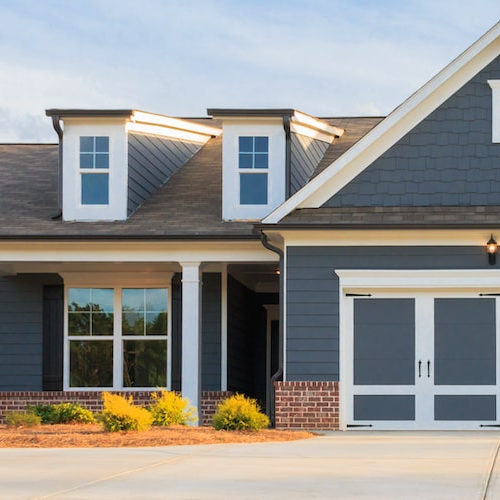Tiny-home financing and loan options
Contributed by Sarah Henseler
Jul 29, 2025
•10-minute read

Buying a tiny home might be on your radar. This especially rings true if you're yearning for a simpler life that's more affordable and gives you greater mobility.
It makes a lot of sense: With housing costs so high, the idea of nesting in small but cozy digs without the hefty price tag might have great appeal.
Unlike buying a traditional home, where you take out a 15- or 30-year mortgage, financing for a tiny house isn't always straightforward.
You might feel flummoxed at first. But being in the know of all the available options – and doing your homework – can help you feel more at ease and steer you toward the best choice for you.
Here, we'll explore all the routes you can take to pay for a tiny home.
Can you get a traditional mortgage for a tiny home?
Tiny homes are 400 square feet or less, and they may be on a set of wheels or built on a permanent foundation.
Most tiny homes don't check off the criteria for traditional mortgages. That's because they often don't meet lender requirements of minimum loan amounts, being on a permanent foundation, and square footage minimums.
Currently, Rocket Mortgage® doesn't offer loans for tiny homes. So while it might be a tad more tough-going to land a loan or financing for tiny homes, there are options out there.
Tiny-house financing and loan options
It can vary, but the average cost of tiny homes in the U.S. can be anywhere from $28,000 to $87,000.
While a mortgage might be off the table for tiny-house financing, there are other routes you can take to shore up funds for your purchase. These hinge on your credit, budget, and goals. Here, we'll walk you through some nontraditional options for a tiny-house finance.
Personal loan
Personal loans are flexible in how they can be used – which is part of their beauty. And because depending on the lender and what you qualify for, you might be able to get a loan up to $50,000 – and in some cases, up to $100,000.
Repayment terms for personal loans can range between 12 and 60 months. As for the interest rate, you can expect it to be between 6% and 36%, with the average rate hovering at 11.57%.
Because they're flexible in how they're used, and you might be able to secure enough financing, a personal loan for a tiny house is one of the most common methods to pay for it.
While personal loans can provide speedy access to the funds and usually don't require collateral, they might also have shorter terms and potentially higher rates. When it comes to the interest rate and terms of your tiny home loan, lenders usually factor in your credit score, income, debts, and the amount and length of the loan.
RV loan
While not technically an RV, you might be able to take out an RV loan. An RV loan for a tiny home could work, but only if it's a mobile tiny home, and if it's RIVA (RV Industry Association)-certified. When a tiny home is RIVA-certified, it means that it's met quality and safety standards that cover fire safety, electrical, and plumbing.
RV loan requirements will vary, and you'll want to look for the minimum credit score and income requirements, and primary residence rules. The lender might also expect a down payment, and this can be anywhere from 10% to 20% of the tiny home's purchase price.
While RV loans for a tiny home may have lower interest rate and longer terms than personal loans, they might come with their own criteria. The minimum credit score is usually anywhere between 660 and 700, and your tiny home might also need to undergo an inspection to get approved for an RV loan.
Rocket Mortgage does not offer RV loans.
Contractor or builder financing
Some tiny-home builders partner with lenders to offer what's known as in-house or third-party financing. Similar to financing with a solar power company that partners with lenders, building financing for a tiny house can be an easier way to finance your home. If you're working with a builder to create the tiny house of your dreams, it can be a one-stop shop.
That said, when it comes to contractor financing options, take the time to research terms, rates, and reliability. This route can be more expensive and come with less favorable terms.
Remember: the choice is yours, and you always have options. Read up on reviews of the builder and see if there's anything said about contractor financing for a tiny house. Compare options outside of what the builder is offering, and ask plenty of questions before signing.
Cash
While this option won't apply to everyone, paying up front with a wad of cash has a lot of benefits – no interest, no debt, and no lender approval needed.
There are a few ways you can make this more feasible. Case in point: If you're not in a rush to get the keys to your tiny home or have it built, consider slowing down your time frame to purchase. That way, you'll have more time to squirrel away funds.
Or, you can consider less-expensive routes, such as going with a prefab tiny home, which is often less expensive than a custom-built one. Or, you can opt for one with fewer frills. Another idea? Aim to save for a larger down payment, which can lower your monthly payments on a tiny-house loan, or shorten the term.
Credit card
Financing a credit card could seem like an easy way to finance your tiny house. By tapping into an existing line of credit, you won't have to apply for a separate form of financing. Plus, your credit won't get impacted because there won't be a lender performing a hard credit pull.
However, you'll want to consider this option with plenty of caution. That's because credit cards have high interest rates. Currently, the average interest rate for credit cards is 21.37%.
Plus, because credit cards are a form of revolving credit, which means you pay as you go up to your credit limit, there's no set repayment date. Plus, carrying a balance and racking up debt can mean a far more expensive debt option.
It's likely your best bet to explore other less-expensive, more sustainable financing options. Your budget and wallet will thank you.
What to know before financing a tiny house
Tiny homes come with unique considerations beyond just how you'll be paying for it. Things will likely come up around hidden costs, lifestyle shifts, and long-term trade-offs. To help you feel more prepared and confident, you'll want to weigh your options.
1. You need land to build on
Even if you're getting a prefab tiny home that's on wheels, you'll need land to park your abode. Here's the thing: land isn't included in the tiny-home price.
While it can be one of the more difficult things to sort out, factoring everything in well ahead of time can help you plan in stages. You'll also need to consider setting up utilities and setting up the proper infrastructure, such as power and running water. Zoning laws and parking considerations also need to be mulled over.
The good news is that you'll have greater freedom to choose where you want to build your tiny home. While it can take more time, you can enjoy more options versus buying a traditional home.
If you'd like to be among like-minded spirits who embrace a minimalist lifestyle, tiny-home communities can be a solid option.
These developments are basically plots of land that you share with fellow tiny-home dwellers, and you won't have to go through the trouble of looking for suitable land to build on – not to mention figuring out how to set up utilities from scratch. Plus, there may be community gardens and social gatherings to partake in.
2. Resale value is usually low
Let's be honest: like RVs and trucks, most tiny homes depreciate, especially if they're mobile. So unlike a traditional home, which builds equity and can increase in value over time, tiny homes will likely lose value.
If you're thinking of passing along a tiny home to your kids, remember that it will likely be used to live in, versus to sell and turn a profit. Because a tiny home is more of a lifestyle choice versus a long-term investment, this can impact the amount you take out in financing, how much you take out for a land loan, and how much you want to invest in terms of frills, amenities, and other features.
3. Consider how you’ll move it
Similar to moving a trailer, you'll need to figure out how to physically move a non-permanent, mobile tiny home. This includes a towing vehicle and other logistics like where you can park your tiny home, and for long. If you'd like your tiny home to be year-round mobile, there are additional costs to consider. These include any rental fees, land fees, and fuel.
4. Tiny homes aren’t allowed everywhere
While the thought of putting your movable tiny home in the middle of the forest or by a tranquil lake might be exciting, the reality is that you'll need to abide by certain rules. Depending on the area, zoning restrictions and permit issues may prevent you from placing or living in a tiny home on certain lots.
However, there is a fair number of options at your disposal. You'll want to do your homework and research local regulations. For example, in one county, permanent tiny homes may be classified and permitted as either an accessory dwelling unit (ADU) or as a movable tiny home. In turn, there are certain size and zoning regulations.
As we talked about, living in a dedicated tiny home community can be easier in many ways. You'll want to weigh the pros and cons of going that route, including costs and more limited options.
5. Consider a small traditional home
Struggling with tiny-home limitations? If you want small-scale living and mortgage financing, consider getting a small traditional home.
For example, a one-bedroom condo, townhouse, or house can give you the minimalist lifestyle. In some ways, it can be a hopeful option where you get the best of both worlds – a cozy home that's more affordable – and can be easier to finance.
To qualify for a mortgage, the home needs to rest on a foundation, qualify for real property status, and be a minimum of 400 square feet. Manufactured homes need to be a minimum of 320 square feet, and built on a permanent chassis. Homes built after June 15, 1976, need a certification label, or HUD tag, slapped onto the home.
FAQ
Is it hard to get financing for a tiny home?
While it's often harder to secure financing for a tiny home than for traditional homes, options do exist. Common ways to finance a tiny home are personal loans, RV loans, builder loans, and credit cards.
While personal loans come unsecured and can give you quick access to funds, they might have shorter terms and higher interest rates.
RV loans might have lower interest rates and longer terms than personal loans, but you'll need to mind their requirements, like an RV inspection prior to securing the financing. Builder financing might be convenient, but you'll want to carefully review the rates and terms.
Can I use an FHA loan to buy a tiny house?
To be eligible for an FHA loan, the home must be at least 400 square feet, be on a permanent foundation, and be HUD compliant. While most tiny homes won't qualify for an FHA loan, some manufactured homes might.
If your home meets the requirements, it's a good idea to explore this route. FHA loans usually have lower down payment requirements, lower interest rates, less stringent credit criteria, and fewer closing costs than other types of mortgages.
What credit score do I need for a tiny-home loan?
The credit score you need for a tiny-home loan depends on the type of financing.
While the minimum credit score for personal loans can vary, lenders typically like to see a credit score of at least 580. That said, you'll usually need a score of at least 700 for more favorable terms. For RV loans, lenders usually require a minimum credit score of 660 – 700. A higher score ups your rates and chances of getting approved.
Are there grants or programs to help finance a tiny home?
While few national programs exist to help finance a tiny home, local or nonprofit support might be available. This might be especially geared toward affordable housing or sustainability initiatives. For example, a down payment assistance program where you partner with one of the nonprofit's build partners.
Spend some time looking for city- and state-level resources. This can lead to free money to help pay for your tiny home.
How much is a down payment on a tiny-house loan?
While personal loans may not require money upfront, RV or builder loans might require a down payment. Traditional home loans, on the other hand, typically require a minimum down payment.
For example, an FHA loan has a minimum down payment of 3.5% of the purchase price of the home. Jumbo home loans can require up to 10% – 25% of the down payment.
The bottom line: Tiny-home financing is possible
While there might be more hurdles to jump through and considerations to mull over, tiny-home financing options are certainly worth exploring. Whether it's a personal loan, RV loan, builder loan, credit card, these are viable routes to take to help you afford that tiny house you have your sights on.
To help you choose the best financing route, you'll want to factor in your budget, details about your tiny home (size, movable or permanent foundation, size, manufactured or custom built), and lifestyle goals. By being aware of the different options, and the pros and cons of each, you can home in on the best one for you.
So while Rocket Mortgage doesn’t offer financing for tiny homes, we’re here to help you learn about all your home loan options. If you decide the time is right for something bigger, get in touch with one of our Home Loan Experts and we’ll go over your options.
Jackie Lam
Jackie Lam is a seasoned freelance writer who writes about personal finance, money and relationships, renewable energy and small business. She is also an AFC® financial coach and educator who helps creative freelancers and artists overcome mental blocks and develop a healthy relationship with their finances. You can find Jackie in water aerobics class, biking, drumming and organizing her massive sticker collection.
Related resources

7-minute read
Cheapest ways to build a house: 12 tips for affordable home building
Building a home can be a viable option for buyers in a competitive market, but expenses can add up quickly. Discover the cheapest ways to build a house.
Read more

12-minute read
20 popular types of houses and home styles
We rounded up the most common types of houses and provided their key features, pros, cons and photos so you can find the home style that best fits you.
Read more

8-minute read
Buying a fixer-upper house: Pros and cons
You can buy fixer-upper houses at lower prices and renovate them to enjoy or sell. Learn how this works – and uncover the pros and cons of buying a fixer-...
Read more